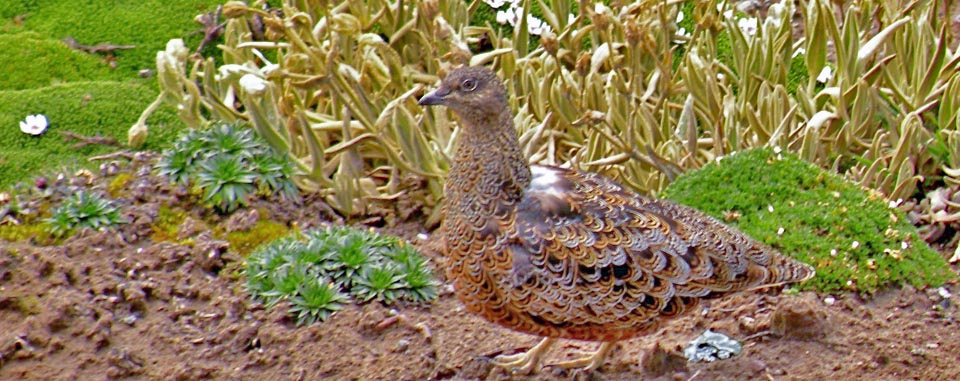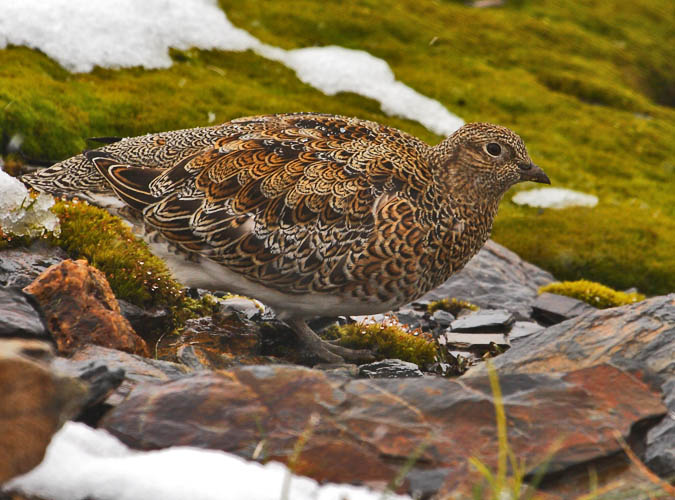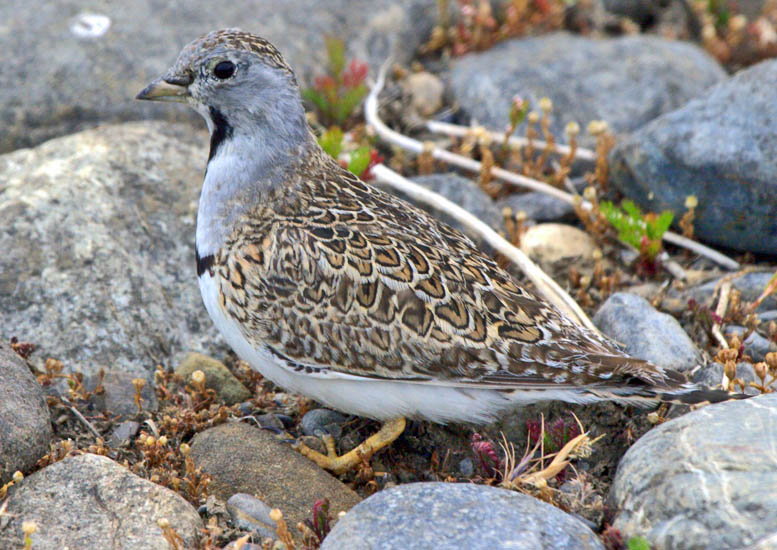
a web page by Don Roberson |
SEEDSNIPES Thinocoridae |
|
White-bellied Seedsnipe (left in a beautiful shot by Adam Riley) is one of two large species in genus Attagis. It is a bird of windswept ridges in southern Argentina and Chile, moving to the Patagonia steppe in winter. The other large species is Rufous-bellied Seedsnipe of the bleak alpine habitat in the high Andes (below, a nice photo by Carole Rose). It looks like she had a sunny day. I was reading my own notes on seeing this species in April 1992, at 3840m [12,600 ft. elevation], up a dirt road above Papallacta Pass, Ecuador, where the "area was in heavy clouds, making visibility very poor, and dreadfully cold, but after a bit of wandering around on the squishy tundra we found a pair." |
 |
Such intricate patterns also are present on the upperparts of the two smaller Thinocorus seedsnipes: Least Seedsnipe and Gray-breasted Seedsnipe T. orbignyianus. This is Least Seedsnipe (right, another exquisite Adam Riley shot). Least Seedsnipe lives in a variety of sparse, open habitats, from sparse fog vegetation in the coastal desert of Peru, to highland semi-desert puna in Bolivia, to very high elevation [3700-4600m; 12,000 to 15,000 ft.] altiplano from southern Peru to northern Argentina. Least Seedsnipe is quite a small species, recalling a snipe or a Pectoral Sandpiper, which winters in the same habitat. Least Sandpiper weighs only 50 grams, while a large Rufous-bellied can weigh up to 400 gr (Fjeldså 1996). The vocalizations of seedsnipe are well known to peasants in the Peruvian and Bolivian highlands, who have given local seedsnipe onomatopoeic local names. The birds are not shy but their cryptic coloration makes them hard to spot. When flushed, their erratic, zig-zagging flight recalls snipes (Fjeldså 1996). As noted at the top of the page, the Australian endemic Plains-Wanderer Pedionomus torquatus may be be closest relative to seedsnipes. It has been theorized that Plains-Wanderer and seedsnipes "could be relicts of an ancient group of grassland charadriiforms which might have dispersed across the Antarctic continent before it was covered with ice in the Upper Miocene period, 10-15 million years ago" (Fjeldså 1996). Seeing a seedsnipe is thus like looking at a bird from the very distant past. |
Photos: Adam Riley photographed the White-bellied Seedsnipe Attagis malouinus at Hidden Lake, Argentina. Carole Rose photographed the Rufous-bellied Seedsnipe Attagis gayi at Pasachoa, Ecuador, on 2 Mar 2009. Adam Riley photographed the Least Seedsnipe Thinocorus rumicivorus at El Calefate, Argentina. Bibliographic note: There is no "family book" for this small family, but the entire set is well-covered in the Handbook of the Birds of the World series (Fjeldså 1996). Literature cited:
|
 Seedsnipes
are comprised of four species of plump ground-dwelling 'shorebirds' in
the Andes and Patagonia, South America. Apparently their nearest
relatives are the thick-knees, the Jaçanas, and the
Plains-wanderer of Australia (Baker et al. 2007) but seedsnipes
diverged from these oddities about 32 million years ago (Prum et al.
2015, Claramunt & Cracraft 2015). Seedsnipes differ from most
Charadriiformes in having a crop, a gizzard, a long intestinal caeca
(pouch), and they lack a hind toe. The intestinal differences arise
from a vegetarian diet (Fjeldså 1996). Overall seedsnipe are
shaped a bit like overgrown sandgrouse but are not related. Sandgrouse,
along with pigeons and Madagascan mesites, are in a group now called
the Columbaves (Prum et al. 2015).
Seedsnipes
are comprised of four species of plump ground-dwelling 'shorebirds' in
the Andes and Patagonia, South America. Apparently their nearest
relatives are the thick-knees, the Jaçanas, and the
Plains-wanderer of Australia (Baker et al. 2007) but seedsnipes
diverged from these oddities about 32 million years ago (Prum et al.
2015, Claramunt & Cracraft 2015). Seedsnipes differ from most
Charadriiformes in having a crop, a gizzard, a long intestinal caeca
(pouch), and they lack a hind toe. The intestinal differences arise
from a vegetarian diet (Fjeldså 1996). Overall seedsnipe are
shaped a bit like overgrown sandgrouse but are not related. Sandgrouse,
along with pigeons and Madagascan mesites, are in a group now called
the Columbaves (Prum et al. 2015).  Both
of these large seedsnipe have absolutely beautifully-patterned
feathering, recalling gorgeous artwork feather by feather. This
camouflage pattern helps them avoid predation in these open country
habitats.
Both
of these large seedsnipe have absolutely beautifully-patterned
feathering, recalling gorgeous artwork feather by feather. This
camouflage pattern helps them avoid predation in these open country
habitats.